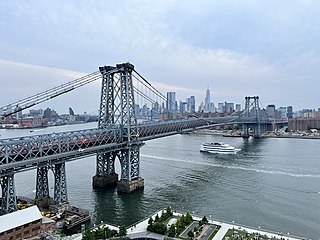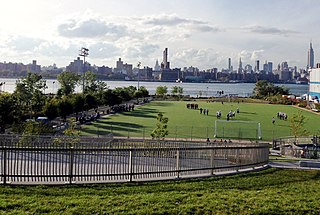
Brooklyn is a borough of New York City located at the westernmost end of Long Island in the State of New York. Formerly an independent city, the borough is coextensive with Kings County, one of twelve original counties established under British rule in 1683 in the then Province of New York. As of the 2020 United States census, the population stood at 2,736,074, making it the most populous of the five boroughs of New York City, and the most populous county in the state. Brooklyn, at 37,339.9 inhabitants per square mile (14,417.0/km2), is the second most densely populated county in the U.S. after Manhattan, as of 2022. Had Brooklyn remained an independent city, it would now be the fourth most populous American city after the rest of New York City, Los Angeles, and Chicago.

Brooklyn College is a public university in Brooklyn in New York City, United States. It is part of the City University of New York system and enrolls nearly 14,000 students on a 35-acre (14 ha) campus in the Midwood and Flatbush sections of Brooklyn as of fall 2023.

Greenpoint is the northernmost neighborhood in the New York City borough of Brooklyn, in the U.S. state of New York. It is bordered on the southwest by Williamsburg at Bushwick Inlet Park and McCarren Park; on the southeast by the Brooklyn–Queens Expressway and East Williamsburg; on the north by Newtown Creek and the neighborhood of Long Island City in Queens; and on the west by the East River. The neighborhood has a large Polish immigrant and Polish-American community, containing many Polish restaurants, markets, and businesses, and it is often referred to as Little Poland.

The Williamsburg Bridge is a suspension bridge across the East River in New York City, connecting the Lower East Side of Manhattan with the Williamsburg neighborhood of Brooklyn. Originally known as the East River Bridge, the Williamsburg Bridge was completed in 1903 and, at 7,308 feet (2,227 m) long, was the longest suspension bridge span in the world until 1924.

Williamsburg is a neighborhood in the New York City borough of Brooklyn, bordered by Greenpoint to the north; Bedford–Stuyvesant to the south; Bushwick and East Williamsburg to the east; and the East River to the west. It was an independent city until 1855, when it was annexed by Brooklyn; at that time, the spelling was changed from Williamsburgh to Williamsburg.

Bushwick is a neighborhood in the northern part of the New York City borough of Brooklyn. It is bounded by the neighborhood of Ridgewood, Queens, to the northeast; Williamsburg to the northwest; the cemeteries of Highland Park to the southeast; and Bedford–Stuyvesant to the south and southwest.

Prospect Heights is a neighborhood in the northwest of the New York City borough of Brooklyn. The traditional boundaries are Flatbush Avenue to the west, Atlantic Avenue to the north, Eastern Parkway – beginning at Grand Army Plaza – to the south, and Washington Avenue to the east. In the northern section of Prospect Heights are the Vanderbilt Rail Yards, built over as part of the Pacific Park project. The Barclays Center, home to the NBA's Brooklyn Nets basketball team, is located in the northwestern corner of the neighborhood in Pacific Park at Flatbush and Atlantic Avenues.
The BMT Canarsie Line is a rapid transit line of the B Division of the New York City Subway system, named after its terminus in the Canarsie neighborhood of Brooklyn. It is served by the L train at all times, which is shown in medium gray on the New York City Subway map and on station signs.
The BMT Jamaica Line, also known as the Broadway - Brooklyn Line, is an elevated rapid transit line of the B Division of the New York City Subway in Brooklyn and Queens. It runs from the Williamsburg Bridge southeast over Broadway to East New York, Brooklyn, and then east over Fulton Street and Jamaica Avenue to Jamaica, Queens. In western Jamaica, the line goes into a tunnel, becoming the lower level of the Archer Avenue lines in central Jamaica. The J and Z trains serve the entire length of the Jamaica Line, and the M serves the line west of Myrtle Avenue.

Jamaica High School was a four-year public high school in Jamaica, Queens, New York. It was operated by the New York City Department of Education.

The High Street station, also signed as High Street–Brooklyn Bridge, and also referred to as Brooklyn Bridge Plaza and Cranberry Street, is a station on the IND Eighth Avenue Line of the New York City Subway. It is located at Cadman Plaza East near Red Cross Place and the Brooklyn Bridge approach in Brooklyn Heights, Brooklyn. Its name comes from older street names; its original location was at the intersection of High Street and Washington Street. It is served by the A train at all times and the C train at all times except late nights.

The Gates Avenue station is a local station on the elevated BMT Jamaica Line of the New York City Subway, located at the intersection of Gates Avenue and Broadway at the border of Bedford–Stuyvesant and Bushwick, Brooklyn. It is served by the Z train during rush hours in the peak direction and by the J train at all other times.

The Grand Street Line is a public transit line in Brooklyn and Queens, New York City, running mostly along the continuous Grand Street and Grand Avenue between Williamsburg, Brooklyn and Maspeth, Queens. It then continues down Queens Boulevard to the 63rd Drive–Rego Park station. Originally a streetcar line, it is now the Q59 bus route, operated by the New York City Transit Authority between Williamsburg and Rego Park, Queens.
The High School for Enterprise, Business, and Technology is a public high school located on the fourth floor of the Grand Street Educational Campus at 850 Grand Street and Bushwick Avenue in the Williamsburg neighborhood of Brooklyn, New York. The school was opened in the fall of 1996 following the closing of Eastern District High School in the spring of that year. The school observes a student dress code. The principal is Holger Carrillo.

The Crosstown Line is a public transit line in Brooklyn, New York City, running along Van Brunt Street and Manhattan Avenue between Red Hook and Long Island City, Queens. Originally a streetcar line, it is now the B61 and the B62 bus routes. The northern section, the B62, is operated by MTA New York City Bus' Grand Avenue Depot in Maspeth, Queens, and the southern section is the B61, operated by MTA New York City Bus' Jackie Gleason Depot in Sunset Park. The entire route was a single line, the B61, until January 3, 2010; the B62 was previously a separate, parallel route between Downtown Brooklyn and Greenpoint, now part of the B43 route. The streetcar line, B61 and the original B62 previously operated from the now-closed Crosstown Depot in Greenpoint.

Bushwick Inlet Park is a public park in the Williamsburg neighborhood of Brooklyn, New York City. The park currently consists of two non-contiguous sections along the East River and is eventually planned to reach into Greenpoint at Quay Street. The park is named for the nearby Bushwick Inlet, which it is planned to encompass upon completion.

The Williamsburg Bridge Plaza, sometimes called Washington Plaza or the Williamsburg Bridge Transit Center, is a major bus terminal and former trolley terminal located at the foot of the Williamsburg Bridge in the New York City borough of Brooklyn, one block west of the Brooklyn-Queens Expressway (I-278). It is situated by the boundaries of Broadway, Havemeyer Street, Roebling Street, and South 5th Street, south of the LaGuardia Playground. It contains five bus lanes, and serves as a terminal for numerous MTA New York City Transit Authority bus routes of Brooklyn and Queens that start and end their runs there.

The Williamsburg Bridge Trolley Terminal, also called the Essex Street Trolley Terminal or Delancey Street Trolley Terminal, was a trolley terminal located underground adjacent to the Essex Street subway station in the Lower East Side of Manhattan. Passenger trolley service operated through the terminal from 1908 until 1948 when trolley service over the Williamsburg Bridge ended. The station was constructed with balloon loops for turning around streetcars after they crossed over the Williamsburg Bridge to send them back to Brooklyn.

The B46 bus route constitutes a public transit corridor in Brooklyn, New York City. The route runs primarily along Utica Avenue north from the Kings Plaza shopping center through Eastern Brooklyn, with continued service west along Broadway to the Williamsburg Bridge Plaza Bus Terminal. The corridor was originally served by a streetcar line, known as the Utica and Reid Avenues Line, Utica−Reid Line, Reid−Utica Line, Reid Avenue Line, or Utica Avenue Line until 1951, when the line was replaced by bus service. The bus route is operated by MTA Regional Bus Operations under the New York City Transit brand.

370 Jay Street, also called the Transportation Building or Transit Building, is a building located at the northwest corner of Jay Street and Willoughby Street within the MetroTech Center complex in Downtown Brooklyn, New York City. The site is bounded by Pearl Street to the west, and was formerly bound by Myrtle Avenue at its north end; this portion of the street has since been de-mapped.























